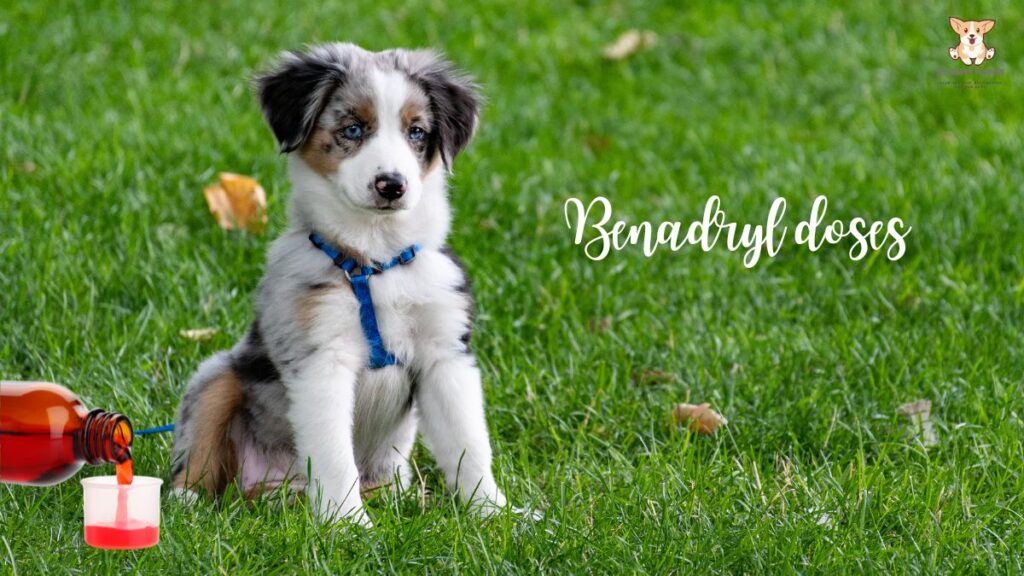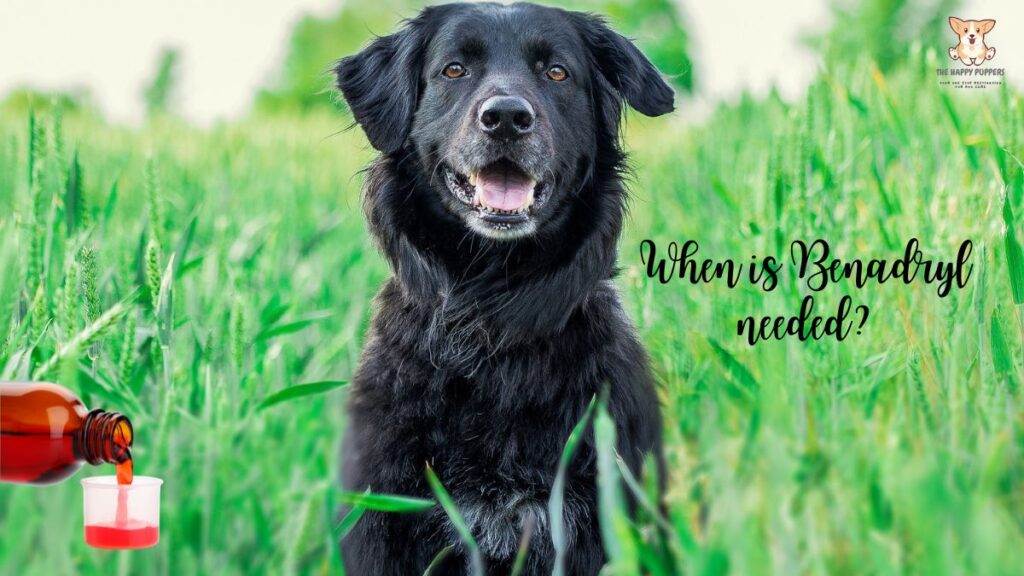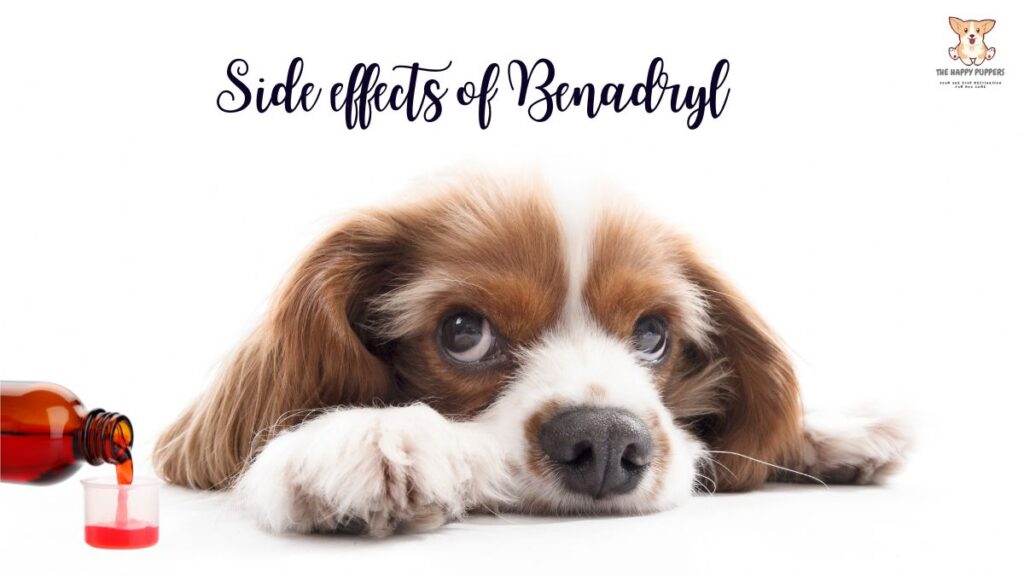Last updated: July 16, 2025
In one of my previous articles, I discussed why is Benadryl used for dogs and puppies. In this article, I will be discussing the Benadryl doses for dogs. Benadryl can come in as a very handy medication in a variety of difficult situations. Let’s first understand when a medication like Benadryl comes in handy for dogs.
There is no doubt that dogs barely lose any energy. I have a two-year-old puppy, Zeus, who is always in the throes of either a zoomie or must irritate his older brother (Delta, 6 years old). So far, he has stayed away from nastiness (eating a bee or some other bug). However, there is no doubt that a rambunctious puppy will end up doing some mischief and land in a sticky situation.
Beyond my own pups, readers have shared valuable insights on using Benadryl. My reader Pia, a busy teacher, noticed her 3-year-old Beagle, Bella, swelling after a bee sting. Following a vet’s advice, Pia gave Bella 12.5 mg (half a 25 mg tablet) based on her 12-lb weight, using the 1 mg/lb guideline. Within an hour, the swelling reduced, and Bella was back to her playful self, proving Benadryl doses for dogs can work wonders in emergencies. Another reader, Ray, used 25 mg for his 25-lb Labrador, Max, during a car trip to ease motion sickness. Max stayed calm, and Ravi was relieved, highlighting the versatility of Benadryl doses for dogs when tailored correctly.
Naughty puppies have landed up in situations ranging from eating a poisonous insect to getting, stung by a bee. These situations can cause serious swelling and make the area extremely itchy and uncomfortable. Just because your dog was being naughty, it does not mean that they should suffer. This is where Benadryl comes in.

Topics covered in this blog post
The need to understand the Benadryl doses for dogs
Diphenhydramine or Benadryl as it is commonly known as, is used to help reduce the signs and symptoms of allergic reactions in both animals and humans. However, it is crucial that you use the right dosage of the medication. This is because in most cases the Benadryl tablets available in the market are meant for human consumption.
Dogs come in various shapes and sizes. Some dogs are small in size while others may be of larger sizes. Furthermore, for the metabolization of Benadryl, dogs have a mechanism that is different from humans. Therefore, administering your dog, a human Benadryl dose can cause more problems.
What is Benadryl?
In simple words; Benadryl is an antihistamine. The active ingredient in Benadryl is diphenhydramine. For dogs, Benadryl has a variety of uses. So far, in dogs, Benadryl has been used to treat:
- Allergy issues
- Puritus
- Respiratory issues
- Coughing [AKC]
- Motion sickness
Cases when Benadryl should not be used:
Don’t give your dog Benadryl if your dog suffers from:-
- Hyperthyroidism
- Glaucoma,
- Urinary retention issues
In some cases, Benadryl showed the opposite effect in the canine. Instead of calming down the dog, Benadryl caused the pup to become more anxious. Furthermore, if your dog is already on other medications, Benadryl can interact with those and causes adverse effects. Thus, always consult your vet before starting your dog on Benadryl.
Benadryl dosage for dogs
The prescribed Benadryl dose for dogs is 2-4 mg/kg. This dose can be administered to the dog there times in one day. In case, you have a larger dog, weighing around 25 lbs (11.3 kg), the dose of Benadryl will be higher. In such cases, the dose will go up from 22.6 mg to 45.2 mg. This dose can be administered to your dog at a maximum of 3 times per day.

Conditions where Benadryl can help.
Now that you know Benadryl doses for dogs, you must understand which disorder warrants the need for using Benadryl. Let’s start the discussion with allergies.
Allergies
Every dog goes through an allergic reaction once in their lives. Benadryl is a drug that can be used the for treatment of several forms of canine allergies like skin issues, food allergies, bee sting allergy, or seasonal allergies. Benadryl doses for dogs can help calm down allergy symptoms like: –
- Hives
- Swelling
- Sneezing
- Itchy skin
- Runny nose
Anxiety
Since drowsiness is one of the common non-harmful side effects of administering Benadryl doses for dogs, many times, Benadryl is also used as a drug to calm dogs who are feeling anxious. This can also be used to help dogs and puppies who face separation anxiety or have to travel for a long duration. This is especially used for dogs who suffer from car sickness or have difficulty traveling. [Chewy]
Motion sickness
As I mentioned above, the sedating effect of Benadryl helps dogs fight motion sickness when they are in a car, train or airplane travel. This is related to the calming effect of Benadryl.

Reaction to vaccines
In most cases, vaccines contain attenuated strains of live viruses or bacteria against which the dog is supposed to develop immunity. In the first year of life, puppies receive a bunch of vaccines sometimes, such vaccines can cause a reaction in the dog. Some common signs of a negative reaction to a vaccine are fatigue or swelling. To control the symptoms of vaccine reactions, veterinarians recommend to the give Benadryl to the puppy a few hours before the vaccination is administered.
Understanding the working mechanism of Benadryl:
In case of an anaphylactic reaction:
Here are five points that will allow you to understand how Benadryl works if used in case of an anaphylactic reaction.
In case of an allergic reaction, the mast cells (white blood cells containing histamine ) undergo degranulation. This causes the mast cells to burst and release histamine. When dogs have been tested, the highest level of histamine has been found in locations like the gastrointestinal, respiratory tract and skin.

The degranulation of mast cells causes the release of harmful chemicals like histamine. This further causes the summoning of the other cells of immune system.
When Benadryl is administered to your dog, it blocks the receptors of histamine present in the smooth muscles and blood vessels. This keeps the histamine from binding to the immune cells that promote allergic reactions. This keeps the allergic reactions from exacerbating. [MetLife Pet Insurance]
Is Benadryl safe for dogs?
In most cases, Benadryl is safe for use in dogs. It can alleviate the symptoms of allergies like swelling, sneezing, itching, etc. However, in certain cases, Benadryl use is not encouraged. I will discuss them in the following sections. So keep reading.
Instruction for Benadryl dosage for dogs
One of the most common veterinary manuals called Merck recommends that the Benadryl dosage for dogs should be 0.9 – 1.8 mg of Benadryl per pound of the dog’s body weight.
In the case of over-the-counter Benadryl, you should go for the 25 mg tablet. Thus, if your dog weighs 25 pounds, he will get one pill. In case he is 50 pounds in weight, you can give your dog 2 tablets. In case you have a dog belonging to the small breeds, you should go for a lower dose liquid formula of Benadryl so you can control the dose.
An alternative to Benadryl is Vetadryl. This is FDA-approved diphenhydramine for cats and dogs. Vetadryl also offers other benefits like availability in a 10 mg dosage. This makes dosing much easier in the case of dogs belonging to small breeds. This drug also comes in different flavours which makes it easier for your pup to consume. [Omni Calculator]
How to Administer Benadryl to Your Dog
Administering Benadryl doses for dogs requires care to ensure safety and effectiveness:
- Measure Accurately: Use a syringe for liquid or cut 25 mg tablets into halves/quarters based on the dosage chart.
- Give with Food: Mix into a small amount of peanut butter or kibble to mask taste and reduce stomach upset [GoodRx].
- Timing: Administer every 8–12 hours, not exceeding three times daily, as per Merck Veterinary Manual.
- Monitor: Watch for 1–2 hours for initial reaction (e.g., drowsiness) and 6–8 hours for side effects.
- Consult Vet: Seek advice if unsure about frequency or response. [Paoli Vet]
Common Benadryl doses for dogs
As I mentioned above, the exact dose of Benadryl will depend on the size and weight of your dog. It will also depend on any other medication that your dog might be taking. If you want to determine the correct dose, the best option is to contact your vet. The most commonly used dosage for dogs is 1-2 mg per pound of body weight of the dog. Never exceed the recommended dosage when administering Benadryl to your dog. If you give your dog Benadryl at a higher dose than needed, it can cause an overdose.
The effects of Benadryl generally last for a period of 6-8 hours. If you are administering Benadryl tablets for your dog, you can chop the tablets into smaller pieces. Always remember, the exact Benadryl dosage for dogs will depend on the medical history and individual needs of your pup.
Benadryl Dosage Chart for Dogs
Below is a guide to Benadryl doses for dogs based on weight, using the standard range of 1–2 mg per pound (or 2–4 mg/kg) up to three times daily. Always confirm with your vet.
| Weight (lbs) | Dose (mg) | Tablets (25 mg) | Liquid (12.5 mg/mL) |
|---|---|---|---|
| 5 | 5–10 | 0.2–0.4 | 0.4–0.8 mL |
| 10 | 10–20 | 0.4–0.8 | 0.8–1.6 mL |
| 20 | 20–40 | 0.8–1.6 | 1.6–3.2 mL |
| 30 | 30–60 | 1.2–2.4 | 2.4–4.8 mL |
| 40 | 40–80 | 1.6–3.2 | 3.2–6.4 mL |
| 50+ | 50–100+ | 2.0–4.0+ | 4.0–8.0+ mL |
Note: Maximum daily dose should not exceed 4 mg/kg or 2 mg/lb per administration, up to 3 times daily. Use Vetadryl for small breeds or consult a vet for precision.
image: Features a weight-based dosage chart, safety tips, and side effect icons, with a CTA: “Download our free Benadryl guide at TheHappyPuppers.com!”]
Benadryl doses for dogs: guidelines
By now, you know that Benadryl is available in various formats like liquids and tablets. When selecting a form of Benadryl for your dog, try to avoid going for the liquid formulation. This is because liquid formulations contain high levels of alcohol. This can be toxic for your pup.

When you go for the Benadryl tablet, make sure that you go for a tablet that only contains diphenhydramine and no other components. For example, medications for sinusitis also contain diphenhydramine. However, along with diphenhydramine, they also contain other active ingredients. These ingredients are extremely dangerous to your pup.
What to do when administering Benadryl tablets?
Normally, Benadryl is available as an over-the-counter medication. The usual doses available in the market are 25 and 50 mg doses. If your dog is heavier than 25 lbs, you can administer the 25mg tablet to your dog three times a day.
However, I would advise you to first take your dog to the vet and get the medical condition confirmed. Get the weight checked and also get a confirmation on the Benadryl doses for dogs.
Liquid Benadryl dosage for dogs.
It can be tough to figure out how much liquid Benadryl you should give your dog. However, there is a simple way to calculate the quantity of Benadryl needed. Start by dividing your dog’s weight (in pounds) by 2.5. The resulting number will give you the dose quantity in milliliters. For example, if your dog weighs 10 pounds, he needs 4 ml of liquid Benadryl.
Interaction of Benadryl with other medications
Benadryl has been known to interact with other drugs. Therefore, it is crucial to inform your vet about all the other medications your dog may be on. Confirm, if giving Benadryl to your puppy is okay. Some of the other medications that tend to interact with Benadryl are: –
- Tricyclic antidepressants
- Anaesthetics
- Sedatives
- Anticholinergic drugs
- Pain medications [Kingsdale]
In case your dog is taking any of the above-mentioned medications or is suffering from a disease that prevents him from taking Benadryl like glaucoma, you can ask your veterinarian for an alternative option.
Benadryl formulations are also available in a time-release formula. Never use this formulation for your dog. The time-release form of Benadryl will break down in your dog’s stomach much faster than normal Benadryl. Thus, there is a risk of overdose in this case.
Drug Interactions and Overdose Management
Benadryl doses for dogs can interact with medications like tricyclic antidepressants, sedatives, and painkillers, potentially amplifying sedation or causing toxicity [PetMD]. Always inform your vet about other drugs your dog is taking. Overdose risks include seizures, rapid heart rate, dilated pupils, and constipation, as noted by Drugs.com.
Vet Insight: “Overdosing on Benadryl can lead to severe neurological effects; monitor for agitation or breathing difficulties and seek emergency vet care immediately if these occur.” — Dr. Michael Hayes, DVM, ASPCA. Dr. Hayes, a toxicology expert, recommends keeping the AVMA Poison Control hotline (1-888-426-4435) accessible during use.
Overdose Management for Benadryl
Overdose from Benadryl doses for dogs can occur if the dosage exceeds 4 mg/kg, leading to severe symptoms. Signs include seizures, rapid heart rate, dilated pupils, and constipation [WebMD]. If suspected, take these steps:
- Stop Immediately: Cease administration to prevent further intake.
- Contact Vet: Call with the dose given and dog’s weight; keep emergency numbers handy [PVEC Vets].
- Provide Support: Offer water if conscious, but avoid forcing; seek fluids or charcoal if directed by a vet.
- Monitor Closely: Watch for worsening (e.g., collapse) and rush to a clinic if breathing difficulties arise.
Side effects of using Benadryl for dogs
Even though Benadryl is considered to be safe for canine consumption, it may show certain side effects. The most common side effect of Benadryl is sleepiness or drowsiness in some cases. This is a desired effect as it will help calm down your dog if he feels nervous or anxious. [Pet Honesty] On the other hand, some of the other not-so-pleasing side effects are:
Diarrhea or upset stomach:
In case your dog shows such symptoms, you must discontinue using Benadryl and immediately consult a veterinarian.

Urinary retention or dry mouth:
Such symptoms are most often the result of taking Benadryl for a long time.
Elevated breathing and heart rate:
If your dog is showing signs of increased heart rate or is parting excessively, it may be a sign of Benadryl overdose stop the medication and get your dog to the veterinarian as soon as possible.
Signs of an overdose in dogs:
- Seizures
- Agitation
- Rapid hast rate
- dilated pupils
- Constipation [St. Michael Vet]
Is Benadryl Safe for Your Dog? Take the Quiz
Answer these 5 questions to assess if Benadryl is suitable for your dog. Consult a vet before use.
- What’s your dog’s weight?
- A) Under 10 lbs
- B) 10–30 lbs
- C) Over 30 lbs
- Does your dog have allergies or motion sickness?
- A) Yes, frequently
- B) Occasionally
- C) No
- Is your dog on other medications?
- A) Yes, sedatives or painkillers
- B) Yes, but not sedatives
- C) No
- Has your dog had adverse reactions to meds?
- A) Yes, severe (e.g., seizures)
- B) Mild (e.g., upset stomach)
- C) No
- Can you monitor your dog for 6–8 hours?
- A) No
- B) Yes, with help
- C) Yes, fully
Results:
- Mostly A’s: Consult a vet; Benadryl may be risky.
- Mostly B’s: Use with caution; start with a low dose and monitor.
- Mostly C’s: Likely safe; follow the dosage chart and watch for side effects.
Alternative options for Benadryl
If your dog showed a bad reaction towards Benadryl, but needs regular allergy treatment, here are some of the alternatives that can be used in the place of Benadryl. You can go for cetirizine or loratadine. Both these options are considered to be safe for consumption by dogs. When you go to get cetirizine on loratadine, they also contain decongestants. Decongestants can cause problems for your dog. Therefore, always talk to your vet before giving your dog the medication.
In case of acute allergic reactions, fast-acting meds may be a better option for your dog. Thus, you should go with shots or cortisone creams [Zigly]. These treatments start working in a matter of minutes. When using cortisone treatments, go for short-term use. If used for the long term, it may cause very nasty side effects.

When to call your vet?
In some cases of allergy, your dog may go into anaphylactic shock due to the allergic reaction.in other rare cases, Benadryl itself can cause problems. in case you notice the following symptoms, immediately call your vet:
- Vomiting
- Experiencing seizures
- Diarrhea
- Difficulty breathing
- Swelling
Conclusion:
Benadryl is an over-the-counter drug that can be used to treat allergies in dogs. it also has a calming and sedating effect, making it very useful for taking your anxious dog on a trip. The Benadryl doses for dogs varies depending on the dog’s body weight. For dogs belonging to smaller breeds, liquid Benadryl should be used.in case you notice side effects, stop the administration and take your dog to the vet.
If you want to know more about dog care, diseases, psychology, and breeds, subscribe to The Happy Puppers. The subscription option is present in the sidebar. Your subscription will allow me to notify you of every new blog post release. If you like watching videos, please subscribe to The Happy Puppers YouTube channel, Shruti and Delta.
Have you ever used Benadryl for your pup? Please share your experiences in the comment section below. If you have any questions, feel free to reach out to me on Twitch. I do coworking streams. Alternatively, you can reach out to me via any of my social media links. I will be happy to help you.
See you in my next blog post
Frequently Asked Questions
Benadryl is an anti-histamine over-the-counter medication. It is normally used to treat a variety of allergies. It is a pretty safe option for treating allergies in the case of dogs as well.
There are many medical conditions for which Benadryl can be given to dogs. It can be used to treat motion sickness, allergies, and itching, and as a sedative if you are taking your dogs on a flight.
Yes! Liquid Benadryl is a good option for dogs. Just adjust the dosage as per your dog’s body weight. For the dosage, you should consult your veterinarian.
Yes! Benadryl is well tolerated by most dogs and can be used as a mild sedative for dogs. However, before you use it as a sedative, discuss the dosage with your veterinarian beforehand.
In case you notice any adverse reaction like collapsing or difficulty in breathing, immediately get veterinary assistance. Always have the emergency numbers at a place where you can easily access them when needed.
Disclaimer: This content is for informational purposes only and not a substitute for professional veterinary advice. Consult a veterinarian before administering Benadryl to your dog, especially for first-time use or if your dog has pre-existing conditions.
References:
- American Kennel Club. Benadryl for dogs.
- Chewy. Benadryl for dogs: Dosage, uses, and side effects.
- MetLife Pet Insurance. Benadryl for dogs: Uses, dosage, and side effects.
- GoodRx. Benadryl for dogs: Is it safe and how much can you give?.
- Paoli Vetcare. How much Benadryl can I give my dog?.
- Kingsdale Animal Hospital. Benadryl dosing for dogs: How to use it safely.
- PetMD. Can I give my dog Benadryl and if so, how much?.
- Drugs.com. How much Benadryl can I give my dog?.
- ASPCA. Diphenhydramine (Benadryl).
- PVEC Vets. Dog Benadryl for fireworks.
- Pet Honesty. How much Benadryl can I give my dog?
- St. Michael Veterinary Clinic. Benadryl dosing.
- Zigly. Benadryl for dogs: Uses, dosage, and side effects.
- WebMD. Can I give my dog Benadryl?
- Merck Veterinary Manual. Antihistamine dosages for integumentary disease in animals.

